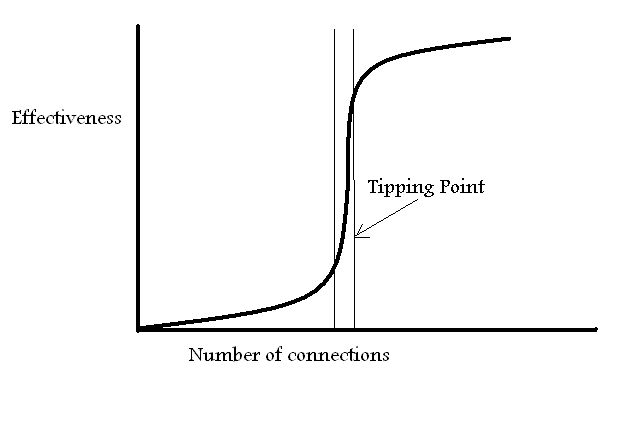Viewing the World: Tipping Points and Social Epidemics
Howon Song
Hs459
11/8/11
The world revolves around tipping points. A tipping point is generally defined as the moment that signals the beginning of a dramatic change; it is the “moment on the graph when the line starts to shoot straight upwards.” Malcolm Gladwell asserts that tipping points are the reasonable explanations for many seemingly uncanny phenomena. He believes that tipping points can be used to explain the momentum behind the spread of AIDS, or the reason that the murder rate in the NYC in the mid 90’s suddenly dropped. More interestingly, such argument has its basis on the idea that not only diseases, but also behaviors and ideas are contagious; in other words, they also have tipping points.
Tipping Point Diagram
Malcolm describes such contagious characteristic of behaviors and ideas under the term “social epidemics.” This term effectively captures the volatility of ideas, behaviors, messages, and products in the world network; how fast they can spread just like diseases. Thinking everything in terms of social epidemics puts one’s perspective about the world into a different spectrum. Social epidemics can be reasonable explanations for every “trend:” the hippie culture in the mid 60’s, fame of Beatles, Global Warming, personal computers, etc. The miraculously successful stories of companies no longer seem mysterious, as they must have figured out the special method to reach the tipping points for their products, services, or ideas. The success of social media like Twitter, Facebook, or Myspace also easily falls into the category of social epidemics. Their marketing strategies effectively lured users, and once a certain number of users became stable and permanent, the “magic” of tipping point led their success as quickly as possible.
Social Epidemics Diagram
Becoming successful is same as approaching a tipping point. The strategies to reach tipping points vary depend on the audience and players; the player could be an entrepreneur, a politician, or an artist, and in each case the effective method to lead a trend among the specific audience and reach the tipping point varies. One of the most important elements that players of tipping points must have is the ability to think like audience. The notorious entrepreneurs like Steve Jobs, Bill Gates, Masayoshi Son, and others were all capable of putting themselves into users’ shoes, and always strived to learn users’ necessities. Although such simple strategy sounds too general and basic in retrospect, such endeavor was their biggest strategy to reach the initial tipping point, and to start leading the booming trend.
Pororo: The Little Penguin
One example of an entrepreneur striving to reach the tipping point of the market can be seen in the case of Pororo: The Little Penguin. Pororo is a computer-graphic animation series that was first created by a small Korean company Iconix Entertainment in 2002, and is now broadcasted in over 80 countries. Recently, Walt Disney offered to acquire Pororo for $1 trillion, but Iconix Entertainment turned down the offer. The president of the company and producer of Pororo, Choi, spoke about his strategies to reach the tipping point and make this animation so popular and successful. First of all, he aimed young children as the primary audience to avoid competition against market-dominating Japanese animations. Secondly, he benchmarked popular animations and set the main character as a penguin, and named him Pororo; he realized that young children are more open to friendly animal characters that are easy to call, just like the “Donald Duck” or “Mickey Mouse.” The other main characters in the animation represent the most stereotypical kids: the curious one, the brave one, the kind one, the shy one, and the bad one. Choi really stepped into the shoes of the audience, and thought like young children. Choi’s such endeavors finally resulted in attracting enough audience to break the tipping point, and his company became one of the most successful histories among the world animation companies.
Sometimes we secretly have acknowledged the contagious effect of our behaviors and ideas but ignored it as they tend to spread so naturally and quickly. Without a solid understanding of the concept of social epidemics and tipping points, it is often difficult to draw an exact correlation between such contagious phenomena and the causes. The above analysis of social epidemics and tipping points gives us an interesting perspective about the world, and helps us draw explanations more easily for miraculous successes or sensations seemingly in disguise.
References:
- http://www.gladwell.com/tippingpoint/index.html
- http://www.nytimes.com/1995/12/31/nyregion/new-york-s-violent-crime-rate-drops-to-lows-of-early-1970-s.html?pagewanted=all&src=pm
- http://www.pororo.net/en/



